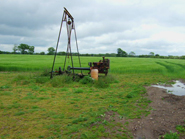8 May 2012
WASHINGTON—As people pump groundwater for irrigation, drinking water, and industrial uses, the water doesn’t just seep back into the ground — it also evaporates into the atmosphere, or runs off into rivers and canals, eventually emptying into the world’s oceans. This water adds up, and a new study calculates that by 2050, groundwater pumping will cause a global sea level rise of about 0.8 millimeters per year.

A new study demonstrates the effect of pumping groundwater, typically for irrigation, on sea level rise.
Credit: John Poyser, via wikimedia commons
“Other than ice on land, the excessive groundwater extractions are fast becoming the most important terrestrial water contribution to sea level rise,” said Yoshihide Wada, with Utrecht University in the Netherlands and lead author of the study. In the coming decades, he noted, groundwater contributions to sea level rise are expected to become as significant as those of melting glaciers and ice caps outside of Greenland and the Antarctic.
Between around 1970 and 1990, sea level rise caused by groundwater pumping was cancelled out as people built dams, trapping water in reservoirs so the water wouldn’t empty into the sea, Wada said. His research shows that starting in the 1990s, that changed as populations started pumping more groundwater and building fewer dams.
The researchers looked not only at the contribution of groundwater pumping, which they had investigated before, but also at other factors that influence the amount of terrestrial water entering the oceans, including marsh drainage, forest clearing, and new reservoirs. Wada and his colleagues calculate that by mid-century, the net effect of these additional factors is an additional 0.05 mm per year of annual sea level rise, on top of the contribution from groundwater pumping alone.
The research team’s article is being published today in Geophysical Research Letters, a journal of the American Geophysical Union.
The last report of the United Nations Intergovernmental Panel on Climate Change in 2007 addressed the effect on sea level rise of melting ice on land, including glaciers and ice caps, Wada said. But it didn’t quantify the future contribution from other terrestrial water sources, such as groundwater, reservoirs, wetlands and more, he said, because the report’s authors thought the estimates for those sources were too uncertain.
“They assumed that the positive and negative contribution from the groundwater and the reservoirs would cancel out,” Wada said. “We found that wasn’t the case. The contribution from the groundwater is going to increase further, and outweigh the negative contribution from reservoirs.”
In the current study, the researchers estimated the impact of groundwater depletion since 1900 using data from individual countries on groundwater pumping, model simulations of groundwater recharge, and reconstructions of how water demand has changed over the years. They also compared and corrected those estimates with observations from sources such as the GRACE satellite, which uses gravity measurements to determine variations in groundwater storage.
With these groundwater depletion rates, Wada and his colleagues estimate that in 2000, people pumped about 204 cubic kilometers (49 cubic miles) of groundwater, most of which was used for irrigation. Most of this, in turn, evaporates from plants, enters the atmosphere and rains back down. Taking into account the seepage of groundwater back into the aquifers, as well as evaporation and runoff, the researchers estimated that groundwater pumping resulted in sea level rise of about 0.57 mm in 2000 — much greater than the 1900 annual sea level rise of 0.035 mm.
The researchers also projected groundwater depletion, reservoir storage, and other impacts for the rest of the century, using climate models and projected population growth and land use changes. The increase in groundwater depletion between 1900 and 2000 is due mostly to increased water demands, the researchers find. But the increase projected between 2000 and 2050 is mostly due to climate-related factors like decreased surface water availability and irrigated agricultural fields that dry out faster in a warmer climate.
If things continue as projected, Wada estimates that by 2050, the net, cumulative effect of these non-ice, land-based water sources and reservoirs — including groundwater pumping, marsh drainage, dams, and more — will have added 31 mm to sea level rise since 1900.
The new study assumes that, where there is groundwater, people will find a way to extract it, Wada said, but some of his colleagues are investigating the limits of groundwater extraction. One way to decrease groundwater’s contribution to sea level rise, he noted, is to improve water efficiency in agriculture — to grow more with less groundwater.
Journalists and public information officers (PIOs) of educational and scientific institutions who have registered with AGU can download a PDF copy of this paper in press.
Or, you may order a copy of the final paper by emailing your request to Kate Ramsayer at [email protected]. Please provide your name, the name of your publication, and your phone number.
Neither the paper nor this press release are under embargo.
“Past and future contribution of global groundwater depletion to sea-level rise”
Yoshihide Wada
Department of Physical Geography, Utrecht University, Utrecht, Netherlands;
Ludovicus P. H. van Beek
Department of Physical Geography, Utrecht University, Utrecht, Netherlands;
Frederiek C. Sperna WeilandDeltares, Delft, Netherlands;
Benjamin F. Chao and Yun-Hao Wu
Institute of Earth Sciences, Academia Sinica, Taipei, Taiwan;
Marc F. P. Bierkens
Department of Physical Geography, Utrecht University, Utrecht, Netherlands, Unit Soil and Groundwater Systems, Deltares, Utrecht, Netherlands.
Yoshihide Wada, Email: [email protected], Telephone: +31 (0)30 253 2776